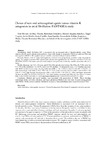Mostrar o rexistro simple do ítem
Choice of new oral anticoagulant agents versus vitamin K antagonists in atrial fibrillation: FANTASIIA study
| dc.contributor.author | Moreno-Arribas, José | |
| dc.contributor.author | Bertomeu-González, Vicente | |
| dc.contributor.author | Anguita, Manuel | |
| dc.contributor.author | Cequier, Ángel | |
| dc.contributor.author | Muñiz, Javier | |
| dc.contributor.author | Castillo-Castillo, Jesús | |
| dc.contributor.author | Sanchis, Juan | |
| dc.contributor.author | Roldán, Inmaculada | |
| dc.contributor.author | Marín, Francisco | |
| dc.contributor.author | Bertomeu-Martínez, Vicente | |
| dc.date.accessioned | 2016-03-14T12:31:38Z | |
| dc.date.issued | 2015-07-30 | |
| dc.identifier.citation | Moreno-Arribas J, Bertomeu-González V, Anguita-Sánchez M, et al. Choice of new oral anticoagulant agents versus vitamin K antagonists in atrial fibrillation: FANTASIIA study. J Cardiovasc Pharmacol Ther. 2016;21(2):150-156 | es_ES |
| dc.identifier.uri | http://hdl.handle.net/2183/16349 | |
| dc.description.abstract | [Abstract] Introduction: Atrial fibrillation (AF) is associated with an increased risk of thromboembolic events. Many patients with AF receive chronic anticoagulation, either with vitamin K antagonists (VKAs) or with non-VKA oral anticoagulants (NOACs). We sought to analyze variables associated with prescription of NOAC. Methods: Patients with AF under anticoagulation treatment were prospectively recruited in this observational registry. The sample comprised 1290 patients under chronic anticoagulation for AF, 994 received VKA (77.1%) and 296 NOAC (22.9%). Univariate and multivariate analyses were performed to identify variables associated with use of NOAC. Results: Mean age was 73.8 ± 9.4 years, and 42.5% of the patients were women. The CHA2DS2-VASc score was 0 in 4.9% of the population, 1 in 24.1%, and ≥2 in 71% (median = 4, interquartile range = 2). Variables associated with NOAC treatment were major bleeding (odds ratio [OR] = 3.36; confidence interval [CI] 95%: 1.73-6.51; P < .001), hemorrhagic stroke (OR = 3.19; CI 95% 1.00-10.15, P = .049), university education (OR = 2.44; CI 95%: 1.55-3.84; P < .001), high diastolic blood pressure (OR = 1.02; CI 95%: 1.00-1.03; P = .006), and higher glomerular filtration rate (OR 1.01, CI 95% 1.00-1.01; P = .01). And variables associated with VKA use were history of cancer (OR = 0.46; CI 95%: 0.25-0.85; P = .013) and bradyarrhythmia (OR = 0.40; CI 95% 0.19-0.85; P = .020). Conclusion: Medical and social variables were associated with prescription of NOAC. Major bleeding, hemorrhagic stroke, university education, and higher glomerular filtration rate were more frequent among patients under NOAC. On the contrary, patients with history of cancer or bradyarrhythmias more frequently received VKA. | es_ES |
| dc.description.sponsorship | Instituto de Salud Carlos III; RD12/0042/0068 | es_ES |
| dc.description.sponsorship | Instituto de Salud Carlos III; RD12/0042/0063 | |
| dc.description.sponsorship | Instituto de Salud Carlos III; RD12/0042/0010 | |
| dc.description.sponsorship | Instituto de Salud Carlos III; RD12/0042/0069 | |
| dc.description.sponsorship | Instituto de Salud Carlos III; RD12/0042/0049 | |
| dc.language.iso | eng | es_ES |
| dc.publisher | SAGE | es_ES |
| dc.relation.uri | http://dx.doi.org/10.1177/1074248415596426 | es_ES |
| dc.subject | Atrial fibrillation | es_ES |
| dc.subject | Anticoagulant treatment | es_ES |
| dc.subject | Vitamin K antagonists | es_ES |
| dc.subject | Nonvitamin K antagonist oral anticoagulants | es_ES |
| dc.title | Choice of new oral anticoagulant agents versus vitamin K antagonists in atrial fibrillation: FANTASIIA study | es_ES |
| dc.type | info:eu-repo/semantics/article | es_ES |
| dc.rights.access | info:eu-repo/semantics/openAccess | es_ES |
| dc.date.embargoEndDate | 2016-07-30 | es_ES |
| dc.date.embargoLift | 2016-07-30 |
Ficheiros no ítem
Este ítem aparece na(s) seguinte(s) colección(s)
-
INIBIC-ECAPE - Artigos [31]
-
GI- GRINCAR - Artigos [216]






